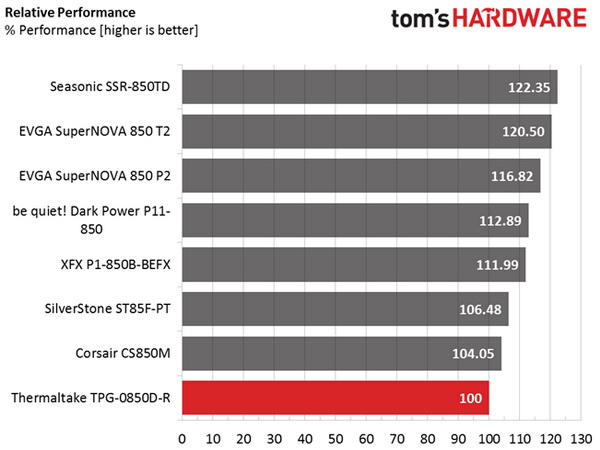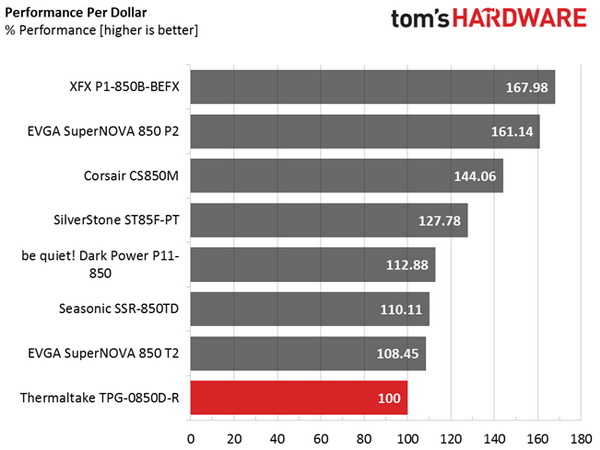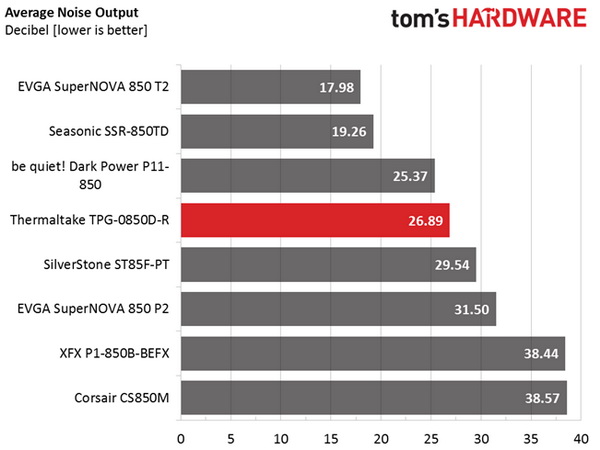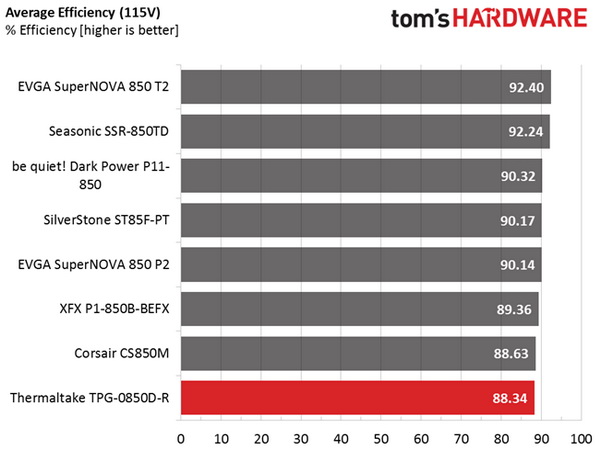Thermaltake Toughpower DPS G RGB 850W PSU Review
In addition to its flagship Titanium line, Thermaltake also equipped the DPS G Gold family with an RGB fan. The highest-capacity model outputting up to 850W is our test subject today.
Why you can trust Tom's Hardware
Performance, Performance Per Dollar, Noise, And Efficiency Ratings
Performance Rating
The following graph shows the TPG-0850D-R's total performance rating, comparing it to other units we have tested. To be more specific, Thermaltake's PSU is shown as 100 percent, and every other unit's performance is shown relative to it.
The +12V rail's bad performance in the turn-on transient tests, the low power-good hold-up time, loose load regulation on the minor rails, and >50mV of ripple at +12V during the full-load test combine to put the TPG-0850D-R into last place compared the competition we charted.
Performance Per Dollar
The following chart may be the most interesting to many of you because it depicts the TPG-0850D-R's performance-per-dollar score. We looked up the current price of each PSU on popular online shops and used those prices and all relative performance numbers to calculate the index. If the specific unit wasn't available in the United States, we searched for it in popular European Union shops, converting the listed price to USD (without VAT). Note that all of the numbers in the following graph are normalized by the rated power of each PSU.
The combination of mediocre performance and a high price leads to a terrible result for Thermaltake.
Noise Rating
The graph below depicts the cooling fan's average noise over the PSU's operating range, with an ambient temperature between 28°C and 30°C (82°F to 86°F).
Thermaltake's offering performs pretty well when it comes to noise, since its fan remains quiet through most scenarios.
Efficiency Rating
The following graph shows the PSU's average efficiency throughout its operating range with an ambient temperature between 28°C and 30°C.
Get Tom's Hardware's best news and in-depth reviews, straight to your inbox.
The overall efficiency we measured is lower than the TPG-0850D-R's direct competitors. The difference reaches up to 1% compared to the Gold-rated XFX offering, which uses a solid Seasonic platform.
Current page: Performance, Performance Per Dollar, Noise, And Efficiency Ratings
Prev Page Ripple Measurements Next Page Pros, Cons, And Final Verdict
Aris Mpitziopoulos is a contributing editor at Tom's Hardware, covering PSUs.
-
powernod -It's not exactly a PSU-related question but more likely a general one.Reply
From the pictures from the monitoring software, i can notice that this software is able to measure CPU and GPU temperature. Do you have any idea if such monitoring is (relatively) accurate?
-Excellent review Aris !! -
Aris_Mp it takes readings from the system's (actually the individual components') sensors. If those are accurate then the software's readings will be accurate as well. Normally they are accurate.Reply -
Nuckles_56 That 12V transient response was certainly interesting, I don't think I've seen one do anything like that beforeReply -
turkey3_scratch Reply18886218 said:That 12V transient response was certainly interesting, I don't think I've seen one do anything like that before
Do what? -
Nuckles_56 Reply18886236 said:18886218 said:That 12V transient response was certainly interesting, I don't think I've seen one do anything like that before
Do what?
Go and plummet back down to almost 0V during the test -
turkey3_scratch Reply18887052 said:18886236 said:18886218 said:That 12V transient response was certainly interesting, I don't think I've seen one do anything like that before
Do what?
Go and plummet back down to almost 0V during the test
I don't think you're reading the transient response graph properly. It's not a measure of voltage but a measure of ripple (well, technically that is a measure of voltage but it's more a measure of instantaneous offsets of an average, or a highly zoomed in sector).
That or I am just missing something. I probably am. Not sure what I'm missing though. Forgive my ignorance. -
Nuckles_56 For this graph http://media.bestofmicro.com/ext/aHR0cDovL21lZGlhLmJlc3RvZm1pY3JvLmNvbS9TLzYvNjIxNzk4L29yaWdpbmFsLzEydl9vZmYuanBn/r_600x450.jpg I hope that I'm not reading it that badly wrongReply -
sparkyman215 Fantastic review Aris! I absolutely love reading in depth articles about anything. Terrible PSU for the price, but it's an awesome review. Congrats!Reply



